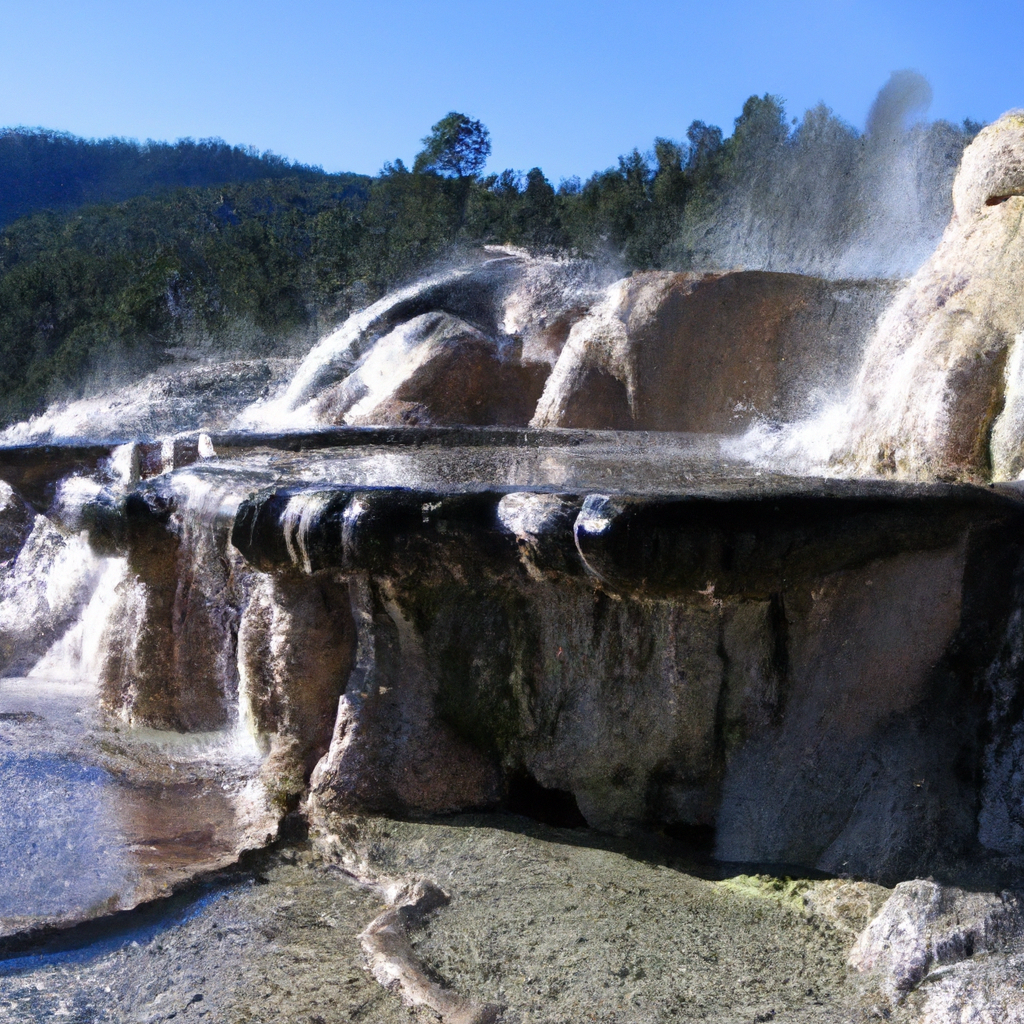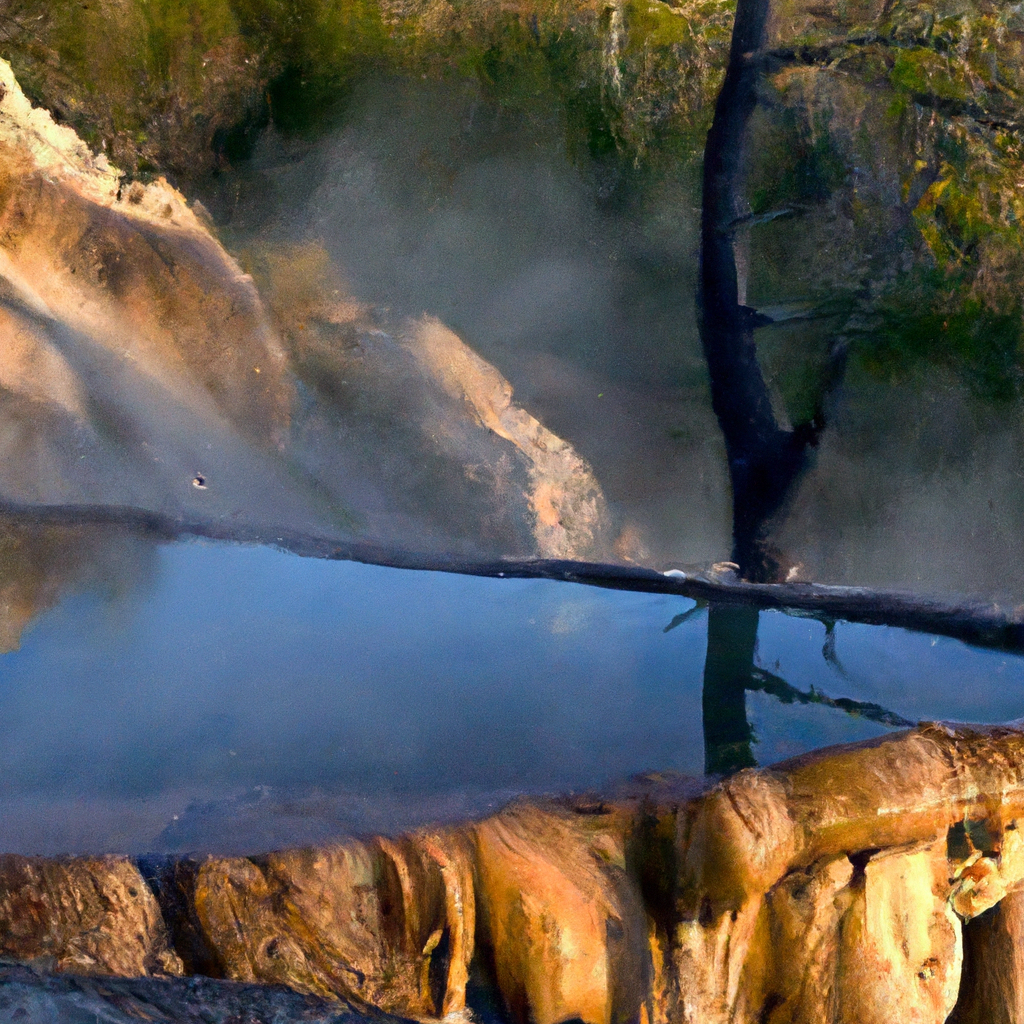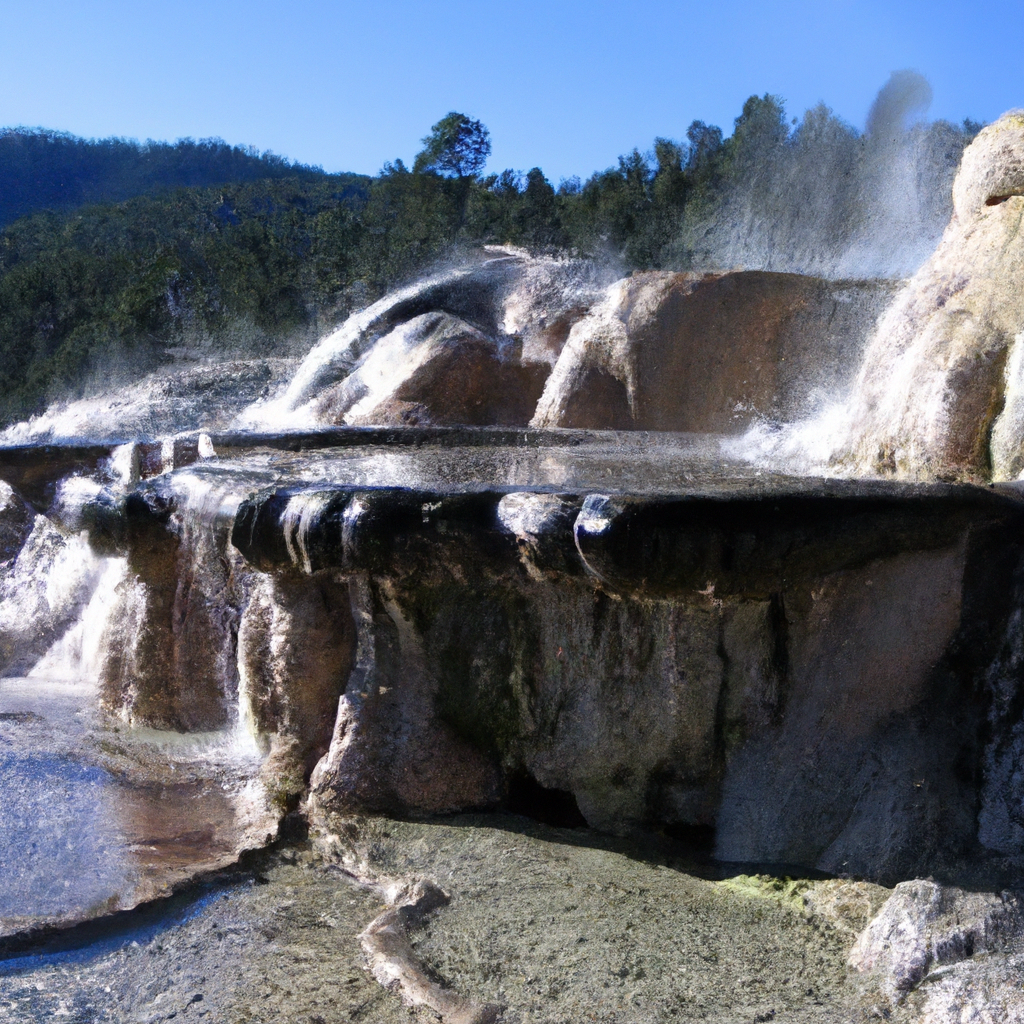Imagine yourself surrounded by the serene beauty of nature, surrounded by towering trees and the sound of rushing water. As you soak in the warm, soothing waters of a U.S. hot spring, you can̵7;t help but marvel at the unique features that make each one so special. From enchanting waterfalls cascading into crystal clear pools to the awe-inspiring eruptions of geysers, U.S. hot springs offer a captivating experience that combines relaxation with the wonders of Mother Nature. Discover the hidden gems and natural wonders that await you as we uncover the unique features of U.S. hot springs.
Hot Springs in the U.S.
Overview of hot springs in the U.S.
Hot springs can be found all across the United States, offering visitors a unique and relaxing experience. These natural wonders are formed when groundwater, heated by the Earth’s geothermal energy, rises to the surface. The hot water is rich in minerals, making it not only relaxing but also beneficial for various therapeutic uses. From the snow-capped peaks of the Rocky Mountains to the lush forests of the Pacific Northwest, there are hot springs to be found in every region of the country, each with its own distinct features and attractions.
Famous hot spring destinations
The United States is home to numerous famous hot spring destinations that attract visitors from all over the world. One of the most renowned is Yellowstone National Park, located in Wyoming. The park boasts a vast number of hot springs, including the iconic Grand Prismatic Spring, known for its vibrant colors and large size. Another popular destination is the Hot Springs National Park in Arkansas, which features the historic Bathhouse Row and offers a range of spa treatments utilizing the healing properties of the hot springs’ water.
Natural Variations in U.S. Hot Springs
Temperature differences
Hot springs in the U.S. exhibit a wide range of temperatures, making each one a unique experience. Some hot springs have scalding hot water that can reach temperatures of over 200 degrees Fahrenheit, while others have pleasantly warm water that is perfect for soaking and relaxation. Whether you prefer a hot soak or a more temperate dip, there is a hot spring in the U.S. to suit your needs.
Mineral content variations
The mineral content of hot springs can vary greatly from one location to another. Some hot springs contain high levels of sulfur, giving the water a distinct smell and providing potential health benefits such as soothing skin conditions and improving blood circulation. Other hot springs may have high concentrations of minerals like calcium, magnesium, and potassium, which can have a rejuvenating effect on the body.
Different colors and textures
One of the most fascinating aspects of hot springs in the U.S. is the wide array of colors and textures that can be seen in the water. Depending on the minerals present, hot springs can range from clear and odorless to vibrant shades of green, orange, and even blue. The unique colors and textures create a visually stunning experience for visitors, adding to the overall appeal of hot springs as natural attractions.

Hot Springs Waterfalls
Description of hot springs waterfalls
Hot springs waterfalls are a special phenomenon where hot spring water cascades down a series of rocky ledges, creating a spectacular display of nature’s power and beauty. As the hot water flows over the rocks, it cools down, creating a refreshing mist that envelops the surrounding area. The combination of the warm water and the cool mist creates a unique sensory experience, making hot springs waterfalls truly breathtaking.
Famous hot springs with waterfalls
One famous hot spring destination with a stunning waterfall is Dunton Hot Springs in Colorado. The waterfall, known as Waterfall #1, attracts visitors with its picturesque setting and the opportunity to soak in the hot spring pools while surrounded by nature’s beauty. Another notable hot springs waterfall can be found at Terwilliger Hot Springs, also known as Cougar Hot Springs, in Oregon. Here, visitors can enjoy a series of cascading pools, each offering different temperatures and relaxation experiences.
Benefits of hot springs waterfalls
Hot springs waterfalls offer not only visual beauty but also therapeutic benefits. The combination of the warm water and the soothing sound of the cascading waterfall creates a tranquil atmosphere that can help reduce stress and promote relaxation. The mist generated by the waterfall also has the potential to improve respiratory health, as the moist air can alleviate congestion and soothe the airways. Soaking in a hot springs waterfall provides a unique and refreshing experience for both the mind and body.
Hot Springs Pools
Types of hot springs pools
Hot springs pools come in various forms, each offering a different experience for visitors. One common type is the natural pool, where hot spring water collects in a small pond or lake. These pools often have a rustic feel, blending seamlessly into the surrounding natural landscape. Another type is the man-made hot springs pool, where the hot water is collected and contained in a specially designed structure that allows for controlled temperature and optimal soaking conditions.
Temperature-controlled pools
Temperature-controlled hot springs pools provide visitors with the opportunity to enjoy the therapeutic benefits of hot springs while maintaining a comfortable temperature. These pools utilize advanced heating and cooling systems to ensure that the water temperature remains constant, allowing guests to soak for longer periods without becoming too hot or cold. Temperature-controlled pools are especially popular in spa resorts and wellness centers, where visitors can indulge in a luxurious and relaxing experience.
Natural rock pools
Natural rock pools are perhaps the most enchanting type of hot springs pool. These pools are formed by the natural flow of hot spring water over rocks, creating small, intimate bathing areas. The rocks serve as natural loungers, providing comfortable seating while the healing waters work their magic. Natural rock pools are often found in remote wilderness areas, offering visitors a chance to connect with nature while enjoying the benefits of hot springs.

Hot Springs Mud Baths
Overview of hot springs mud baths
Hot springs mud baths combine the therapeutic properties of hot springs water with the detoxifying effects of mud. In these baths, a special type of clay or mud, rich in minerals and organic compounds, is mixed with hot spring water to create a thick, nutrient-rich substance. Visitors are then immersed in the mud, allowing the minerals to be absorbed through the skin and provide various health benefits.
Benefits and therapeutic uses
Hot springs mud baths have been used for centuries for their healing and rejuvenating properties. The minerals and organic compounds present in the mud can help nourish the skin, improve blood circulation, and promote detoxification. The heat from the hot springs water stimulates the opening of pores, allowing for deeper absorption of the mud’s beneficial components. Additionally, the mud’s exfoliating properties can leave the skin feeling softer and smoother.
Famous hot springs with mud baths
One famous hot spring destination known for its mud baths is Calistoga in Napa Valley, California. Calistoga Mud Baths offer visitors the chance to immerse themselves in a mix of volcanic ash, peat moss, and hot spring water. The mud is said to have numerous skincare benefits, leaving visitors feeling rejuvenated and refreshed. Another notable hot springs location offering mud baths is Ojo Caliente Mineral Springs Resort and Spa in New Mexico. Here, guests can choose from a variety of mud treatments, all designed to promote relaxation and wellness.
Hot Springs Geysers
Definition and characteristics of geysers
Geysers are remarkable geological features that can only be found in a few locations around the world, including the United States. They are hot springs that periodically erupt with boiling water and steam, creating a dramatic display of nature’s power. Geysers have a unique plumbing system beneath the Earth’s surface, consisting of a water reservoir heated by volcanic activity and a narrow vent that leads to the surface. The pressure builds up within the reservoir until it exceeds the weight of the water above, resulting in an explosive eruption.
Famous hot springs with geysers
One of the most famous hot spring locations with geysers is, again, Yellowstone National Park. The park is home to the world’s largest concentration of geysers, including the famous Old Faithful. This iconic geyser consistently erupts approximately every 90 minutes, shooting boiling water as high as 180 feet into the air. Another notable geyser can be found at Lassen Volcanic National Park in California. The Bumpass Hell area features a variety of geothermal features, including a geyser that erupts with impressive force.
Geothermal energy utilization
Hot springs with geysers not only provide a stunning natural spectacle but also serve as valuable sources of geothermal energy. Geothermal power plants harness the energy from the hot springs and convert it into electricity. This renewable energy source has the potential to reduce reliance on fossil fuels, making it an environmentally friendly alternative. By utilizing the geothermal energy present in hot springs, communities can contribute to a more sustainable future.
Hot Springs Caves
Overview of hot springs caves
Hot springs caves are unique geological formations formed by the interaction of hot spring water and limestone rock. Over time, the hot water dissolves the limestone, creating caverns and tunnels that house the hot springs. These caves often have stunning stalactite and stalagmite formations, giving them an otherworldly appearance. Hot springs caves are a fascinating natural phenomenon, offering visitors the chance to explore underground wonders while enjoying the therapeutic benefits of the hot springs.
Formation process of hot springs caves
The formation of hot springs caves begins with the movement of groundwater through rock layers, where it absorbs minerals and becomes heated by geothermal activity. The hot water then rises to the surface, eroding and dissolving the limestone along the way. Over thousands of years, the dissolved limestone re-deposits, creating intricate cave systems. The hot springs within these caves are often characterized by beautiful crystal formations, making them both visually stunning and geologically significant.
Exploration and tourist attractions
Hot springs caves present unique opportunities for exploration and tourism. Many caves are open to the public and offer guided tours, allowing visitors to marvel at the natural beauty of the underground world. Carlsbad Caverns National Park in New Mexico is one such destination, featuring a series of caves, some of which contain hot springs. Exploring these caves provides a chance to witness the mesmerizing beauty of the stalactites and stalagmites, as well as experience the therapeutic benefits of the hot springs within.
Hot Springs Fumaroles
Definition and characteristics of fumaroles
Fumaroles are another remarkable feature associated with hot springs. They are openings in the Earth’s crust that emit steam and gases, often accompanied by a strong smell of sulfur. Fumaroles occur when hot spring water or other geothermal fluids come into contact with cooler air or surface water, causing the water to rapidly evaporate and release steam and gases. These vents can be found in volcanic regions and are a testament to the underground activity happening beneath the Earth’s surface.
Famous hot springs with fumaroles
One notable hot spring location with fumaroles is the geothermal area of Rotorua in New Zealand. Known for its unique geological features, including numerous fumaroles, Rotorua attracts visitors from around the world. In the United States, the geothermal area of Mammoth Hot Springs in Yellowstone National Park is another famous hot springs location with fumaroles. The steam and gases emitted by the fumaroles create an otherworldly atmosphere, adding to the allure of these natural wonders.
Impact on local ecosystems
Fumaroles have a significant impact on the surrounding ecosystems. The gases released by fumaroles can create harsh conditions, making it difficult for plants and animals to thrive in the immediate vicinity. However, some microorganisms have adapted to these extreme conditions and can survive in the presence of sulfur and other gases. These unique ecosystems around fumaroles showcase the ability of life forms to adapt and thrive in even the most challenging environments.
Hot Springs Terraces
Formation of hot springs terraces
Hot springs terraces are formed when hot spring water flows over a series of terraced mineral deposits, creating stunning natural formations. As the mineral-rich water cascades down the terraces, it leaves behind layers of minerals such as calcium carbonate, silica, and sulfur. Over time, these layers build up, creating colorful and intricately patterned terraces that resemble steps or cascading pools. Hot springs terraces are a rare and captivating sight, offering a unique blend of artistic beauty and geothermal wonder.
Famous terraced hot springs
One of the most famous terraced hot springs is Mammoth Hot Springs in Yellowstone National Park. The vibrant colors and unique patterns of the terraces create a mesmerizing spectacle, attracting photographers and nature enthusiasts alike. The terraces here are constantly changing and evolving due to the flow of hot spring water and the deposition of minerals. Another notable terraced hot spring is Travertine Hot Springs in California. These terraces are tucked away in the eastern Sierra Nevada mountains and provide a serene and picturesque setting for relaxation.
Tourist activities
Hot springs terraces offer a range of activities for visitors to enjoy. Many locations have boardwalks or trails that allow visitors to explore the terraces up close, offering the opportunity to marvel at their intricate designs and vibrant colors. Some terraced hot springs even have designated soaking areas, providing a unique and intimate bathing experience surrounded by the picturesque terraces. Whether you choose to soak in the mineral-rich waters or simply admire the natural beauty, hot springs terraces offer an immersive and memorable experience.
Hot Springs Wildlife
Unique ecosystems around hot springs
Hot springs create unique ecosystems that support a diverse range of plant and animal life. The warm water and nutrient-rich environment provide ideal conditions for certain species to thrive. Microorganisms, such as bacteria and algae, are often found in hot springs water and play a crucial role in the ecosystem by serving as the foundation of the food chain. Additionally, some hot springs are home to fish species that have adapted to the warm waters, creating specialized habitats within the larger ecosystem.
Endangered species in hot springs areas
Hot springs areas can also serve as important habitats for endangered species. For example, the hot springs in Arkansas are home to the Ouachita rock pocketbook, a freshwater mussel species listed as endangered. The clean and stable conditions of the hot springs provide a suitable environment for the survival and reproduction of this vulnerable species. By preserving and protecting hot springs, we can help safeguard the habitats of endangered species and contribute to their conservation efforts.
Conservation efforts
Conservation efforts are essential to preserve the unique ecosystems and natural features of hot springs. National parks and protected areas play a crucial role in safeguarding hot springs and their surrounding environments. These areas implement measures to ensure the responsible use and enjoyment of hot springs, while also protecting the habitats of the diverse wildlife that call these areas home. By promoting sustainable tourism practices and raising awareness about the importance of conservation, we can help preserve hot springs for future generations to enjoy.
In conclusion, hot springs in the United States offer a diverse range of natural variations, from temperature differences to mineral content variations, different colors and textures, and a variety of formations such as waterfalls, pools, mud baths, geysers, caves, fumaroles, terraces, and more. Each unique feature provides visitors with a distinct experience and an opportunity to connect with the healing power of nature. Additionally, hot springs support unique ecosystems and contribute to the conservation of endangered species. So, whether you’re seeking relaxation, natural beauty, or a deeper understanding of our planet’s geothermal wonders, exploring the hot springs of the U.S. promises a truly unforgettable journey.
